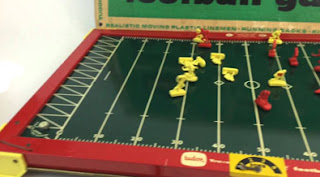Vintage
1950s Toys
Electric
Football
Electric Football can be traced back to 1929 when Elmer Sas
incorporated Tudor Metal Products in New York City. The company survived the
Depression and in the late '40s, Elmer's son Norman became president of Tudor
and invented the game, Electric Football.
Norman Sas based the game on a vibrating car
race game that Tudor already made. The early #500 Electric Football models were
crude to the modern eye but were the first tabletop football game which
featured actual moving players as they reacted to the vibrations created by the
electromagnet motor under the metal field. Actual passing and kicking was also
a unique feature of this first of its kind design.
Electric
Football was an immediate hit and became one of the hottest items at Christmas
time from the late '50s and '60s and to date has sold 70 million games. Tudor
did so well with the game that other companies also entered the market; Coleco,
Munro and Gotham. Over the coming years, some of Electric Football's greatest
innovations would come out of the competition between the companies.
The
Electric Football today features many
local, regional, national and even international leagues and tournaments with
hundreds of coaches participating and a
World Championship tournament and convention.















